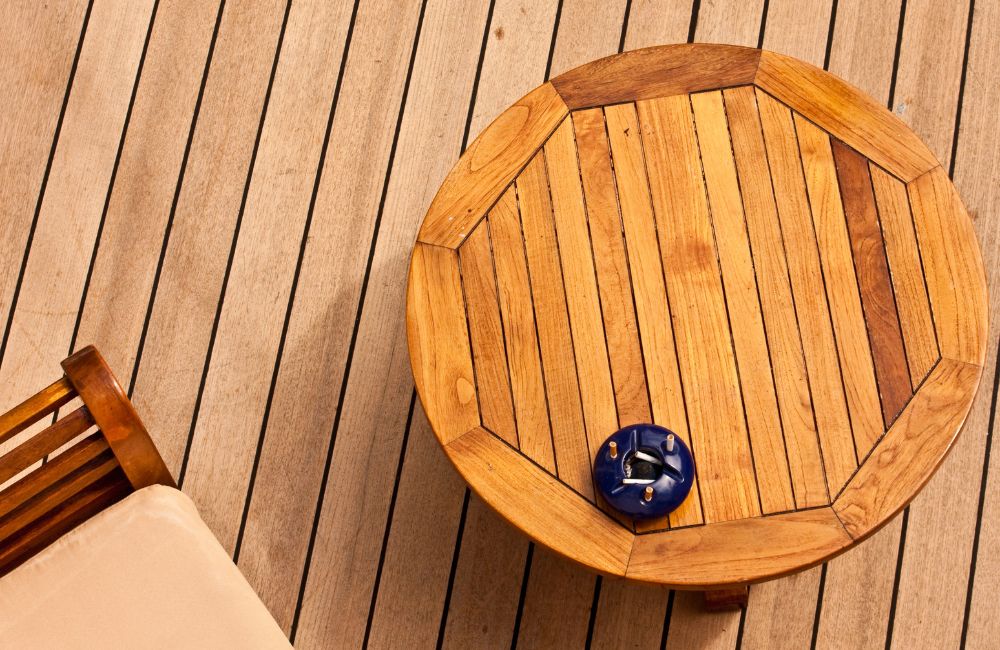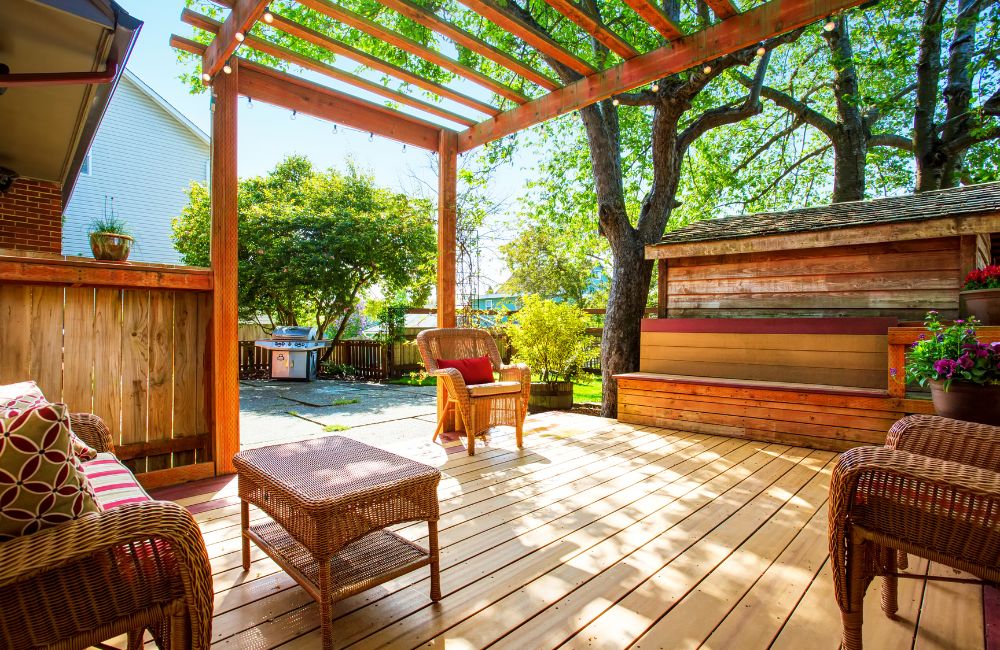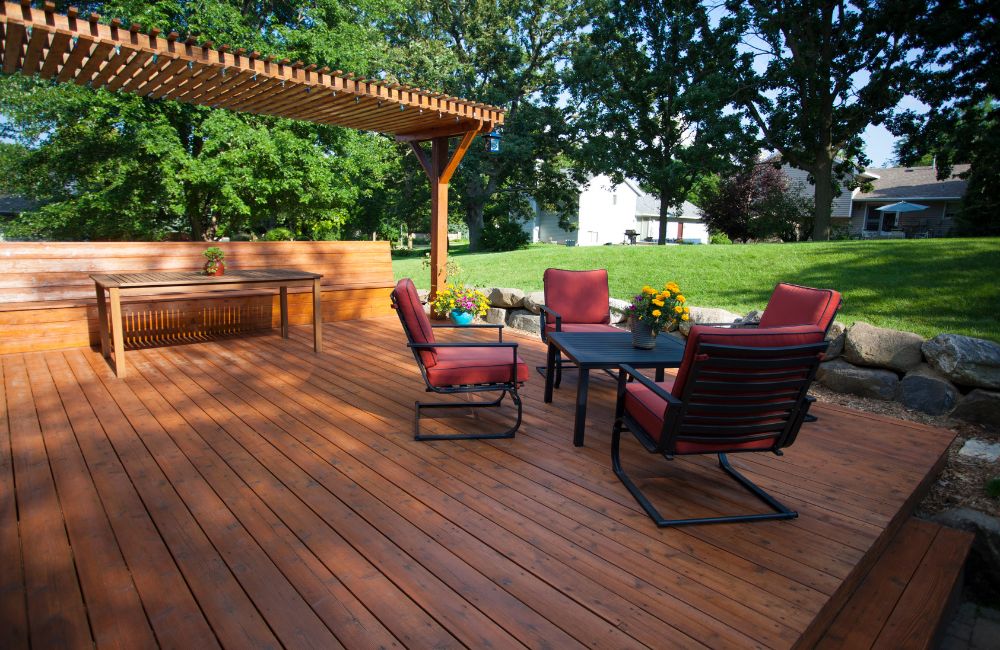Table of Contents
Key Takeaways
7 Indicators It’s Time to Stain Your Deck: A Guide by House Painters
Sign 1: Faded Color
Sign 2: Water Absorption
Sign 3: Visible Cracks and Splinters
Sign 4: Mold and Mildew Growth
Sign 5: Warping and Cupping
Sign 6: Peeling or Flaking Stain
Sign 7: Gray or Weathered Wood
Frequently Asked Questions
Revitalize Your Deck with Custom Colonial Painting
| Key Takeaways ✔ When the deck’s previous stain starts to fade, this indicates the need for staining. ✔ Water absorption shows the current stain is ineffective. ✔ Visible cracks and splinters signal the wood needs sealing. ✔ Mold and mildew growth highlight moisture issues requiring stain. ✔ Warping and cupping show excess moisture exposure. ✔ Peeling or flaking stain means the finish has failed. ✔ Gray or weathered wood indicates oxidation and needs restoration. |
A well-maintained deck is not only a beautiful addition to your home but also a functional outdoor space that can withstand the elements. However, according to house painters in Westport, CT, exposure to sun, rain, and varying temperatures can take a toll on your deck’s appearance and structural integrity. Recognizing the signs that your deck needs staining is crucial to preserving its beauty and durability.

7 Indicators It’s Time to Stain Your Deck: A Guide by House Painters
Keeping your deck in top condition requires regular maintenance, including timely staining. Recognizing when it’s time to re-stain can prevent damage and extend the life of your deck. Here are seven indicators that it’s time to stain your deck, as advised by professional house painters.
Sign 1: Faded Color
Over time, the intense UV rays from the sun break down the pigments in the stain, causing the color to appear washed out and less vibrant. This fading is typically a surface-level issue, meaning the wood itself might not be damaged or compromised, but it does indicate that the deck’s protective layer is no longer effective.
Why Color Matters in Protecting Wood
The color of a deck is not just for aesthetic appeal; it plays a crucial role in protecting the wood from various elements. Here’s why maintaining the color is essential according to house painters:
- Moisture Barrier: A properly stained deck repels water, preventing moisture from penetrating the wood and causing rot or mold growth.
- Temperature Regulation: Darker stains can help in absorbing heat, whereas lighter stains reflect it, helping to manage the deck’s temperature.
Indicators that Fading Is Beyond Normal Wear and Tear
It’s normal for a deck to experience some fading over time, but there are specific indicators that suggest the fading has gone beyond normal wear and tear. House painters look for these signs to determine if a deck needs immediate attention:
- Uneven Coloration: Patches of the deck that are significantly lighter or discolored compared to other areas.
- Bare Wood Exposure: Areas where the wood grain is visible, indicating that the stain has completely worn off.
- Chalky Residue: A powdery substance on the deck’s surface, which signifies the breakdown of the wood’s surface due to UV exposure.
- Loss of Water Repellency: If water no longer beads on the surface but instead soaks in quickly, it’s a clear sign that the protective stain layer is compromised.
Sign 2: Water Absorption
When a deck is properly stained, water should bead up on the surface, similar to droplets on a freshly waxed car. This beading effect demonstrates that the wood is effectively repelling water, which is crucial for its longevity and durability. Conversely, if water quickly absorbs into the wood, leaving dark, wet spots, it indicates that the protective layer is compromised. House painters emphasize that regular staining helps maintain this barrier, ensuring the deck remains in excellent condition.
Simple Tests to Check Water Absorption
Homeowners can perform a few simple tests to determine whether their deck needs staining. House painters recommend the following methods to check for water absorption:
- Water Drop Test: Sprinkle water on the deck; if it beads up, the stain is effective. If it absorbs, restaining is needed.
- Spray Bottle Test: Mist a section of the deck; quick absorption in some areas indicates worn-out spots needing attention.
- Dark Spot Test: After rain, look for dark spots where the wood absorbed water, signaling a compromised protective layer.
Sign 3: Visible Cracks and Splinters
Visible cracks and splinters on your deck are clear indicators that it requires attention. According to house painters, over time, weather conditions and regular use can cause the wood to dry out, leading to these issues. Not only do cracks and splinters detract from the deck’s appearance, but they also pose safety hazards, especially for children and pets.
Steps to Prevent Cracks and Splinters
House painters recommend the following steps to keep your deck in top condition:
- Regular Inspection: Periodically inspect the deck for early signs of cracking and splintering.
- Timely Repairs: Address minor cracks and splinters immediately to prevent them from worsening.
- Consistent Staining: Apply a high-quality stain every 2-3 years to maintain the wood’s protective barrier.
- Proper Cleaning: Keep the deck clean from debris and dirt that can hold moisture against the wood.

Sign 4: Mold and Mildew Growth
Mold and mildew thrive in environments where moisture and darkness are prevalent. Decks exposed to these conditions are particularly vulnerable. As per house painters, common conditions that promote mold and mildew growth include:
- High Humidity: Consistently high humidity levels provide the perfect breeding ground for mold and mildew.
- Poor Ventilation: Lack of airflow around and under the deck can trap moisture, encouraging fungal growth.
- Standing Water: Water that pools on the deck surface or in crevices can lead to mold and mildew development.
- Shaded Areas: Decks that are in constant shade or have shaded spots are more likely to develop mold and mildew due to reduced drying from sunlight.
Health Risks and Structural Damage Caused by Mold
Mold and mildew not only mar the appearance of a deck but also pose serious health risks and can cause structural damage over time. Key concerns include:
- Health Risks: Exposure to mold spores can cause or worsen respiratory conditions like asthma and allergies, and direct contact can lead to skin irritation and rashes. Prolonged exposure may weaken the immune system, resulting in more frequent illnesses.
- Structural Damage: Mold and mildew cause wood decay by breaking down fibers, leading to rot and weakening deck components, creating unsafe conditions. Additionally, house painters say that mold and mildew stains can be difficult to remove, leaving unsightly discoloration.
How Staining Prevents Mold and Mildew Growth
Staining a deck is a crucial preventative measure that house painters recommend to combat mold and mildew growth. Staining offers several protective benefits:
- Moisture Repellence: Quality stains create a barrier that prevents water from penetrating the wood, reducing the moisture content that mold and mildew need to thrive.
- Smooth Surface: Staining seals the wood, creating a smoother surface that is less likely to trap dirt and moisture, both of which contribute to mold growth.
- Easy Cleaning: A stained deck is easier to clean and maintain, making it simpler to remove mold and mildew before they can cause significant damage.
Sign 5: Warping and Cupping
Warping and cupping are common issues that arise when moisture penetrates deck wood. When wood absorbs water, it expands, and as it dries out, it contracts. This constant cycle of expansion and contraction can cause the wood to lose its shape. Warping typically occurs when the entire board twists out of its original form, while cupping happens when the edges of the board rise higher than the center, creating a concave shape.
Signs of Warping and Cupping in Deck Boards
Identifying warping and cupping early can prevent further damage and maintain the deck’s structural integrity. House painters recommend looking for the following signs:
- Uneven Surface: Boards that are no longer flat but have a noticeable bend or twist.
- Raised Edges: The edges of the deck boards are higher than the center.
- Gaps Between Boards: Irregular gaps can form due to the distortion of the wood.
- Difficult to Walk On: The deck surface becomes uneven, posing a tripping hazard.
Sign 6: Peeling or Flaking Stain
Peeling or flaking stains on a deck is a clear sign that it needs attention. According to house painters, the primary causes of peeling and flaking stain include:
- Improper Surface Preparation: Before staining, the deck surface must be thoroughly cleaned and dried. Failure to remove dirt, mildew, or previous coatings can prevent the new stain from adhering properly.
- Poor Quality Stain: Using a low-quality stain or one that is not suitable for exterior use can lead to peeling and flaking.
- Weather Conditions: Staining during unfavorable weather conditions, such as high humidity, rain, or extreme temperatures, can affect the stain’s ability to bond with the wood.
- Inadequate Application: Applying the stain too thickly or unevenly can cause it to sit on the surface rather than penetrating the wood, leading to peeling over time.
Difference Between Normal Wear and Problematic Peeling
Understanding the difference between normal wear and problematic peeling is crucial for proper deck maintenance. Here’s how to distinguish between the two as per house painters:
- Normal Wear: Over time, a stained deck will naturally lose some of its color and luster due to exposure to sunlight and foot traffic. This fading is gradual and even across the surface.
- Problematic Peeling: Problematic peeling is characterized by patches of stain lifting off the deck, exposing bare wood. This often occurs in larger, uneven sections and can be accompanied by flaking.
Steps to Take if the Current Stain is Peeling or Flaking
If a deck’s stain is peeling or flaking, it is essential to address the issue promptly to prevent further damage. Follow these steps recommended by professional house painters:
- Assess the Damage: Inspect the entire deck to determine the extent of the peeling and flaking, identifying areas where the stain is lifting and checking for underlying wood damage.
- Remove the Peeling Stain: Use a paint scraper or deck stripper to remove the loose and peeling stain. For larger areas, consider using a power washer to expedite the process, ensuring all loose material is thoroughly removed to create a smooth surface.
- Clean the Deck: Clean the deck with a wood cleaner or a mixture of water and mild detergent, scrubbing the surface with a stiff brush to remove dirt, mildew, and any remaining stain residue. Rinse the deck thoroughly and allow it to dry completely.
- Sand the Surface: Sand the deck to smooth out rough areas and improve stain penetration, focusing on areas where the stain was removed to ensure a uniform surface. Clean off any sanding dust before proceeding.
- Choose the Right Stain: Select a high-quality, exterior-grade stain suitable for the deck’s wood type, and consult with house painters for recommendations on the best products for long-lasting results.
- Apply the Stain: Follow the manufacturer’s instructions for stain application, applying the stain evenly using a brush, roller, or sprayer, working in small sections. Allow the stain to penetrate the wood and wipe off any excess to prevent pooling.
- Seal and Protect: After the stain has dried, consider applying a clear sealant for additional protection. Regularly inspect the deck and reapply the stain as needed to maintain its appearance and durability.

Sign 7: Gray or Weathered Wood
Over time, wood exposed to outdoor elements undergoes photodegradation and photooxidation as part of the natural weathering process. This natural process leads to the breakdown of the wood’s surface fibers, resulting in a gray, weathered appearance. The UV rays from the sun break down the lignin in the wood, which is responsible for holding the wood fibers together. Without this binding element, the wood gradually loses its natural color and takes on a silvery-gray hue.
Benefits of Restoring the Original Color with Stain
Restoring a deck to its original color with the help of professional house painters offers several advantages:
- Enhanced Aesthetics: Applying a quality stain rejuvenates the wood, bringing back its rich, natural color and making the deck look new again. Stains come in various colors and finishes, allowing homeowners to choose a look that complements their home’s design.
- Improved Protection: Staining provides a protective barrier against harmful UV rays, preventing further oxidation and fading. Additionally, stains help to repel water, reducing the risk of water damage, mold, and mildew growth.
- Increased Durability: A well-applied stain seals the wood’s surface, preventing cracks, splinters, and other forms of surface degradation. Regular staining by house painters extends the life of the deck, ensuring it remains safe and functional for years to come.
- Cost-Effective Maintenance: Regular staining is a cost-effective way to maintain the deck, avoiding more expensive repairs or replacements in the future. Hiring experienced house painters ensures that the stain is applied correctly, maximizing its protective benefits and longevity.
Frequently Asked Questions
How often should I stain my deck?
The frequency of staining your deck depends on several factors, including the type of wood, the quality of the stain, and the local climate. Generally, it is recommended to stain your deck every 2-3 years. However, decks in harsher climates with more exposure to sun and rain may require more frequent staining. Regular maintenance, such as cleaning and inspecting for damage, can help determine when it’s time to restain.
Can I stain a new deck right away?
New decks should not be stained immediately; they need time to dry out completely. Depending on the type of wood and climate, this drying process can take anywhere from a few weeks to several months. Pressure-treated wood, for instance, can retain moisture for a longer period. Staining too early can trap moisture in the wood, leading to issues like mold and poor adhesion of the stain. It’s best to test the wood’s moisture content before staining to ensure it’s ready.
What is the difference between staining and sealing a deck?
Staining and sealing serve different purposes, although they are often used together. Stains penetrate the wood to add color and enhance its appearance while providing some level of protection. Sealers, on the other hand, are primarily used to create a waterproof barrier that protects the wood from moisture. Combining both ensures that your deck has both aesthetic appeal and strong protection against the elements. Some products offer both staining and sealing in one application for convenience.
Can I stain my deck myself, or should I hire a professional?
Staining a deck can be a DIY project if you have the right tools, materials, and patience. However, hiring a professional like house painters ensures that the job is done efficiently and correctly. Professionals have the expertise to choose the right products and techniques for your specific deck. House painters can also save you time and effort, especially if your deck is large or has intricate details. Weigh the cost of professional services against the time and potential mistakes of doing it yourself.
What are common mistakes to avoid when staining a deck?
Common mistakes include staining without proper preparation, applying the stain in direct sunlight, and using the wrong type of stain. Not cleaning the deck thoroughly can prevent the stain from adhering properly. Applying stain in direct sunlight can cause it to dry too quickly, leading to uneven coverage. Using the wrong type of stain for your wood or climate can result in poor performance and durability. It’s also important to avoid over-application, which can lead to a sticky surface and long drying times.

Revitalize Your Deck with Custom Colonial Painting
Bring new life to your deck with the professional staining services of Custom Colonial Painting in Westport, CT. Our dedicated team in Westport, CT, uses high-quality stains to protect and enhance the beauty of your deck. Schedule an appointment today to experience the difference Custom Colonial Painting can make for your deck in Westport, CT!









